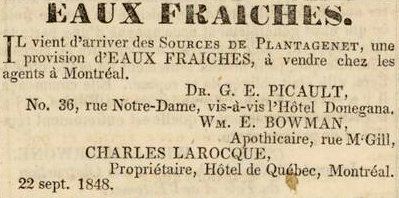Apothecary
Learn about the occupation of an apothecary, the ancestor of our modern-day pharmacist, in New France and Canada.
Cliquez ici pour la version française
L’Apothicaire | The Apothecary
“Louis Hébert, apothecary at Port-Royal, Acadia,” 1938 painting by C. W. Jefferys (National Historical site of Port-Royal).
The apothicaire or apothecary, is the ancestor of the modern pharmacist. In New France, apothecaries often served dual roles as doctors or surgeons. Such was the case of Robert Giffard, the seigneur of Beauport, who was reportedly both a surgeon and an apothecary.
The apothecary composed, prepared, and sold drugs, tonics, and liniments based on a person's description of their illness and symptoms. He provided bedside care, made bandages, and administered medications and healing plants. The apothecary could prescribe medicine as he saw fit or fill prescriptions from doctors. He was also the sole health professional to prepare and administer enemas.
The apothecary’s shop, typically located in his home, was stocked with drugs and essential tools like distillers, mortars, pestles, scales, retorts, demijohns and ovens. In the fall, he would order basic products from France, which arrived in the spring when ships returned to the colony. The shop was normally separated into two sections: a retail space where medicines were displayed in jars and bottles, and a private space that contained the apothecary’s laboratory and storage room.
Medicines were made from flowers, leaves, resins, roots, bark, fruits, seeds, ground flours, and animal products like eggs, milk, butter, honey, horse manure, and crab’s eyes. Minerals such as sea salt, alum, antimony, sulphur, mercury, lead, amber, and coral were also used. Chemistry skills were crucial for apothecaries.
Apothecary Chest, 18th century (McCord Stewart Museum Montréal)
Many institutions, including Hôtels-Dieu, hospitals, and Jesuit colleges, had their own apothecaries. Indigenous peoples' extensive knowledge of natural medicine, particularly healing herbs, was often shared with European colonists and incorporated into their practices.
From 1610 to 1788, there were 20 apothecaries in Canada, with 8 practicing after the British Conquest.
Apothecary ads in the newspaper L’Avenir on September 27, 1848 (Bibliothèque et Archives nationales du Québec)
Apothecary Jar, 1666-1700 (McCord Stewart Museum Montréal)
Apothecary Jar, circa 1710 (McCord Stewart Museum Montréal)
Individuals recorded in this profession: Alexandre-Joseph-Xavier Arnoux/Arnould, Jean-François Bache, Gervais Baudouin, Joseph Beckett, François Benoist, Pierre Berthon, William Binley, Jean Jard Boispineau, Claude Boiteux de Saint-Olive, Pierre Bolduc, William Bowman, Louis-Joseph Brown, Louis-Amable Cazeneuve, Pierre Chabot dit Lusignan, Jean-Baptiste Chrétien, James Cockburn, Joseph Dauquin, Pierre de Sales-Laterrière, John Adam Duff, Guillaume Fontaine, Robert Giffard, Olivier Giroux, Auguste Globensky, Gaspard Gouault, Louis Hébert, John Hurst, Joseph Leblanc, George Longmore, Louis Lyman, Louis Moine, William Moretain, Olivier Morin, Liveright Pieze/Piuze, Josiah Pomeroy, Henry Porter, Abner Price, Charles George Rath, Henry Taylor, Rodolphe Trudeau, Romuald Trudeau, Marc Antoine Vignau.
German Pharmacy (“Pharmacie Rustique”), 1774 drawing by G. Locher, engraved by Bartholomew Hübner in 1775 (Wikimedia Commons).
“Apothecary's habit,” print by Nicolas de Larmessin III (Paris Musées)
Sources:
Claude Lemay, "Fonctions et métiers délaissés," l'Ancêtre, number 281, volume 34, winter 2008, and number 280, volume 34, winter 2007; electronic edition, Société généalogique de Québec (www.sgq.qc.ca/images/_SGQ/R_LAncetre_plus_libre/ENT-FONCTIONS-METIERS-DELAISSES.pdf).
Jeanne Pomerleau, Arts et métiers de nos ancêtres : 1650-1950 (Montréal, Québec: Guérin, 1994), 21-28.
"Daily Life: Health and Medicine," Virtual Museum of New France, Canadian Museum of History (https://www.historymuseum.ca/virtual-museum-of-new-france/daily-life/health-and-medicine/), based on original research by Stéphanie TÉSIO, Ph.D.







